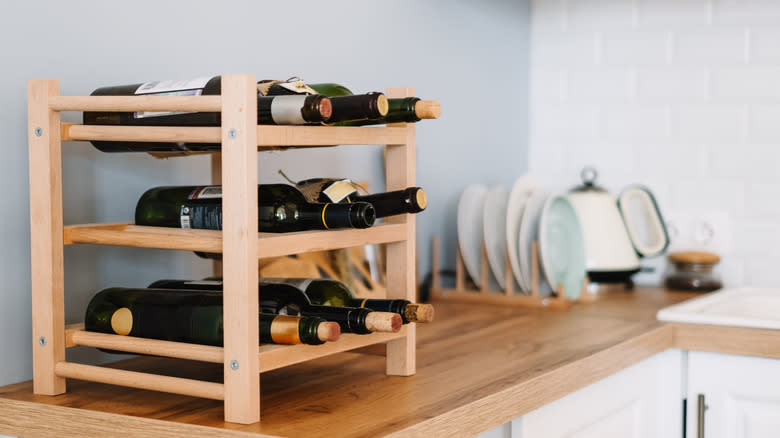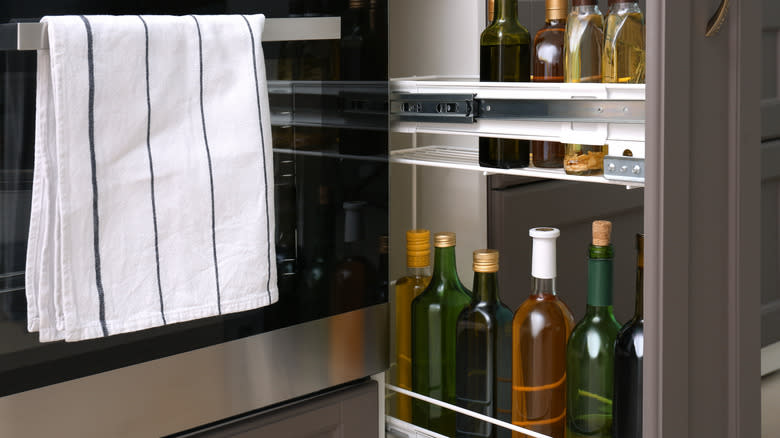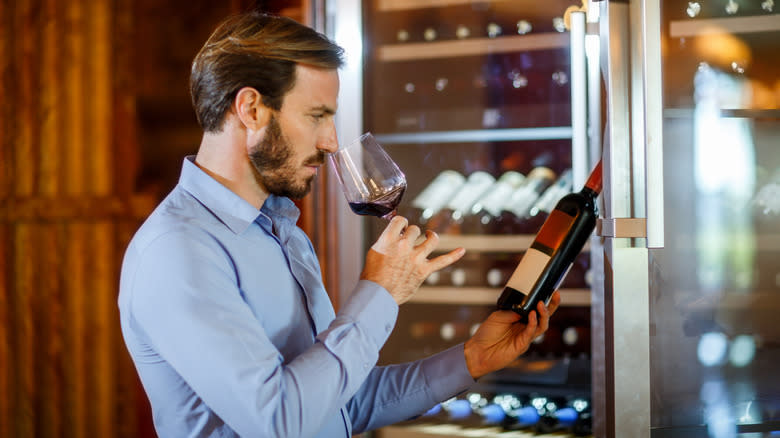The Absolute Worst Place To Store Wine In Your Kitchen

Whether you invested in a $100 bottle of luxury wine or a $10 box of wine, the question of where to store your libation isn't always crystal clear. Wine is an extremely dramatic beverage -- the fermentation process is a delicate art that requires precise conditions to perfect smell, color, consistency, and most importantly, taste. But after wine has been bottled, sold, and brought home, it can still easily be altered if it isn't stored correctly.
Experts recommend you keep wine in cool, dark, and virtually unvisited locations. The ideal place is arguably a wine cellar, but many of us do not have the room (or the disposable income) to add one, so look instead for somewhere like a cupboard, closet, or a shelf on the far side of the dining room, away from any windows. It can also be helpful to pay attention to the places where wine should not be stored. Keeping it in the wrong place can alter wine's flavor drastically, and is one reason that wine goes bad much earlier than it should. One of the worst places to store your wine is on your kitchen counter, especially near the oven. According to wine experts, you want to avoid anywhere that experiences excessive light, temperature fluctuations, and especially heat, either from the sun or cooking appliances.
Read more: 10 Of The Healthiest Beers You Can Drink
Know Wine Enemies: Heat, Light, Air

Temperature is paramount for proper wine storage. In an interview with Club Oenologique, London-based sommelier Leroy Bradley Tomlinson advises keeping bottles away from ovens. "They're the hottest part of your house and in my opinion, nothing should go next to your oven, not even your cooking oil -- it just ruins the flavor," Tomlinson said. When cooking with wine, the heat cooks out the alcohol content and changes the wine's flavor. This alteration can also happen on a slightly smaller scale when wine is stored in a place that gets too hot. Heat above 80 degrees Fahrenheit can cause wine to develop a sour flavor profile; a risk if you store wine next to your oven.
Wine can also be affected the longer it sits on a kitchen counter. Changes in room temperatures and light patterns can warm bottles of wine that have been left out, and cause the beverage to taste spoiled or flat. Temperature fluctuations or light aren't the only things that can damage the flavor of wine: Oxygenation can cause wine to taste sour or even bitter. Oxygenation happens when a wine has been exposed to air, which is inevitable once a bottle is opened. Storing a bottle of wine on its side, with the bottom slightly elevated (like in a wine rack) allows gravity to keep the wine touching the cork, which keeps the cork moist. A dry cork can shrivel enough to allow air to seep in.
Get Crafty With Your At-Home Wine Placement

Finding the correct storage space for your wine might take some time. First, identify what your specific type of wine needs for optimal preservation. In addition to other differences between red and white wines, they also have different storage requirements. Most robust to dry red wines prefer a cool, slightly humid location that does not see much light or circulating air and is away from high-traffic areas such as the kitchen and living spaces. This is especially true for wines that age best over longer periods; vintage wines need a dark, cool storage space similar to the conditions of a wine cellar to continue the aging process and preserve the flavors. Think the back of your closet, or under the bed in the guest room.
Some wines, however, do not take well to aging. Most fresh whites and sparkling wines are best opened within a few days of purchase, making their need for storage space a more temporary concern. This is where storing wine in your refrigerator -- or even better, a wine fridge -- can be ideal. A wine fridge is designed to provide the ideal conditions for wine; however, depending on where you put the wine in a regular fridge, the location may be too warm or cold, or the temperature could change each time the door is opened and closed.
Read the original article on Daily Meal

